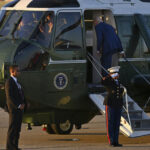France advocates putting boots on the ground while UK says Kiev can use its weapons to strike targets inside Russia

Two weeks after the US president, Joe Biden, signed off on a US$60 Billion Package of military aid to Kiev, the impact on the battlefield has been relatively modest.
According to an assessment by the Washington-based think tank the Institute for the Study of War on May 6, Russian offensive operations have continued unabated. Vladimir Putin’s invasion force continues to achieve incremental territorial gains along key parts of the frontline in the east and south.
The most critical battle at the moment appears to be around the eastern town of Chasiv Yar, just ten kilometers west of Bakhmut, which Russia captured a year ago. If the town were to fall, it would be an indication of both Russia’s success on the battlefield and the incredibly slow pace of the conflict. Nevertheless, it would be a further indication that despite the US aid package momentum in the war remains with Russia, for now.
It would have been unrealistic to expect Ukraine to regain the military initiative immediately. This is despite the fact that the US defense department had already positioned key supplies,including air defense capabilities and artillery ammunition, in advance of Biden’s signature and was able to deliver these to Ukraine in some cases within hours.
But the continuing Russian advance also indicates likely delays on the Ukrainian side in distributing new supplies to frontline troops. And even when these logistical problems are overcome, they will not necessarily quickly make up for the unfavorable overall balance in equipment and manpower that Ukraine still faces.But neither should the impact of the US aid package be dismissed as irrelevant. It provides Ukraine with a lifeline.
Its stocks of vital war-fighting equipment had been depleted to such an extent that a Ukrainian defeat did not just seem possible, but increasingly probable. Apart from a boost to morale, the US aid package will likely buy Kiev enough time to repel a Russian offensive that is expected later this spring.
This would almost certainly ensure that Ukraine and its European allies will be in a position towards the end of 2024 when they can produce enough equipment and ammunition to see Kiev through what will likely be another difficult winter – regardless of the outcome of the US elections in November.
Hardening positions in Europe
As always, there is a bigger picture here as well which provides some clues about the trajectory of the war.
The French president, Emmanuel Macron, recently urged his European partners to contemplate sending troops to Ukraine as a last resort to prevent a Russian victory. When Macron initially floated this idea in February, it was roundly rejected by key NATO allies.
Nothing came of it at the time but the fact that it is back on the table is due, to some extent at least, to French grandstanding. So far only Lithuania has responded somewhat positively, indicating it would be prepared to send troops to Ukraine on a training mission.
But Macron’s vision suggests that any hawks in the broader debate about how Europe should respond to the threat that Russia undoubtedly poses well beyond this war have found a powerful ally in the French president.
A similar change of direction is indicated in the UK. While Lord Cameron, the British foreign secretary, continues to rule out “boots on the ground” in Ukraine, he has explicitly affirmed that Kiev can use UK-supplied weapons systems to strike targets inside Russia.
This hardening of French and British positions prompted Russia to announce drills for its tactical nuclear forces. This kind of nuclear saber-rattling is nothing new and was likely expected in Paris and London. But Britain’s decision suggests that at least some in the West are prepared to call Putin’s bluff.
Using British weapons to hit targets in Russia was previously a red line the UK government was unwilling to allow Kiev to cross. This reversal in the British position gives Cameron’s gambit an immediacy well beyond even Macron’s boots-on-the-ground rhetoric and explains why the Kremlin’s response has also included threats to strike the Uk.Thanks to the US aid package, growing European capabilities, as well as its own increased capacity to manufacture arms, Ukraine is now in a position to target Russian supply lines, storage areas and bases in the immediate areas on the other side of the border. This could significantly diminish Moscow’s ability to mount and sustain future large-scale offensive operations.
Even if Ukraine was successful in doing this, it would not suddenly turn the tide decisively in its favor. But it would relieve some of the pressure that Russia had been able to apply of late and add an element of uncertainty to Putin’s calculations about the outcome of the war against Ukraine and – perhaps more so – the wider geopolitical confrontation with the West.
No end in sight
In this uncertainty, Moscow is not alone. In Washington, too, there are still few, if any, signs of a clear sense of the endgame or its timing. The US national security advisor, Jake Sullivan, seems content that US military aid will allow Ukraine to hold the line for the remainder of the year and possibly to mount another counteroffensive in 2025.
On the upside, that Ukraine is still in a position to deny Russia a victory on the battlefield is a testament to the country’s will to fight and to the ability of its Western partners to assist in that fight. On the downside, it suggests that to the extent that there is any Western strategy it appears to remain focused on preventing Ukraine’s defeat, rather than enabling its victory.
Above all, it is not a strategy for ending the war. This halfhearted support will not only continue to prevent a negotiated compromise but might ultimately lead to defeat for Ukraine – and the West.



